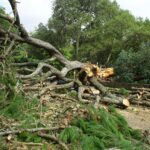At a glance:
- Proper replanting of trees after removal involves selecting the right tree, preparing the soil, and finding the right location.
- Caring for new trees requires watering, mulching, fertilising, and pruning.
When you have a dead or damaged tree in your backyard, consider removing the tree to ensure safety and prevent property damage. Once you remove the dead or damaged tree, it creates a void in your backyard. Planting a new tree in the same spot is a great way to solve that problem. However, planting trees in that same location requires some additional effort. Here we discuss how you can replant trees and care for new trees after tree removal.
Choosing the right Tree Species
It is important to choose the right species of trees before planting a new tree. For planting trees in Melbourne, select species that can grow and thrive in Melbourne’s soil and climate conditions. It is also important to consider the root system and size of the tree at maturity to avoid potential damage to property or electricity lines. Trees that grow in excess require regular pruning and trimming.
The most suitable trees for the Melbourne area are Callistemon, Banksia, Eucalyptus, and Acacia. Tree removal services in Melbourne can provide homeowners in the Melbourne area with valuable assistance in choosing the right tree species to plant in their landscape. The arborists are continuously helping homeowners in Melbourne by providing knowledge of local conditions and tree planting advice with necessary tree care services.
Choosing and Preparing the Planting Site
You should choose a proper planting site with favourable soil conditions. Some trees grow long roots and limbs at maturity, which can hamper your property. So, choosing where your trees can grow fully without interfering with your property is important. Then prepare the site for planting new trees. The plantation site should be clear of old trees and debris to provide ample space for growth.
It is also important to ensure enough sunlight and adequate drainage in the plantation site for trees to thrive. If the plantation site has compact soil structure, you need to loosen the soil for roots to grow properly. To improve soil nutrition, you can add organic matter (compost) before planting trees.
Planting Trees Correctly
You should follow proper tree plantation techniques to ensure the survival and growth of your new trees. Start with a suitable planting hole. The planting hole should be dug properly – twice or thrice the root ball’s width, but only as deep as the root ball. Planting trees too deep is not appropriate for tree growth. Keep the top of the root ball level with the surrounding soil. Fill the hole gently, and make sure to stabilise the root ball while filling the hole. Compact the ground firmly to remove air pockets.
Providing Proper Tree Care and Maintenance
Regular tree care and maintenance are also important to govern the health of growing trees. You should water your trees regularly and mulch the soil around the trees if needed. Young trees require watering once a week to grow. Avoid overwatering as it causes root rot and other problems. On the other hand, mulching helps to regulate soil temperature and retain moisture.
Besides watering and mulching, trees require extra care to thrive. Regular tree pruning helps in shaping the trees and removing damaged tree limbs. Fertilising can also provide necessary nutrients for growing trees, but it should be done meagerly and only at the right time of the year. You can consult with Same Day Tree Works arborists on when and how to add fertiliser to your trees.
Common Mistakes to Avoid When Replanting
Here are some common mistakes to avoid when caring for a new tree:
Overwatering:
New trees require a balance of water and oxygen to thrive. Overwatering can suffocate the root and rot them.
Fertilising too soon:
Fertilising newly planted trees is not suitable for the root system; it can burn the roots and damage the trees. Start fertilising only when the tree establishes a strong root system.
Ignoring diseases and pests:
Keep an eye on any signs of diseases and pest infections. Early investigation can prevent big problems down the road.
Not mulching:
Mulching helps retain moisture, regulate temperature, and suppress weeds. But, too much mulching can lead to rot in the tree’s trunk. So, avoid too much mulching also.
Pruning too much:
Newly planted trees require little to no pruning during the fest few years of growth. Over-pruning can lead to too much stress on trees, so it is best to prune trees when needed.
Replanting and caring for new trees require proper and regular care. If you need more confidence about planting and caring for a new tree, you can seek professional help. Professional arborists at tree removal in Melbourne have the experience and expertise to ensure safe and proper tree plantation. They are here to help with any tree care services in Melbourne.





